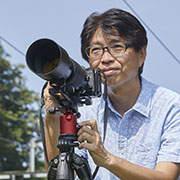Koji Yoneya | Markins Ball Head
Theme
Railway Photos
Photographer
Koji Yoneya
Date
June-July 2019
Location
Fukushima Prefecture
Device
Markins
Q10i-RD Ballhead
VR15J-SS VR-Holder
PV-80 + LV-170 Universal L-Plate SET
PL-55 Lens Plate
PL-75 Lens Plate
VR15J-SS VR-Holder
PV-80 + LV-170 Universal L-Plate SET
PL-55 Lens Plate
PL-75 Lens Plate
FUJIFILM
X-T3
XF18-55㎜F2.8-4 R LM OIS
XF50-140mmF2.8 R LM OIS WR
XF100-400mmF4.5-5.6 R LM OIS WR
XF14mmF2.8 R
XF23mmF1.4 R
XF35mmF2 R WR
XF1.4X TC WR
XF2X TC WR
XF18-55㎜F2.8-4 R LM OIS
XF50-140mmF2.8 R LM OIS WR
XF100-400mmF4.5-5.6 R LM OIS WR
XF14mmF2.8 R
XF23mmF1.4 R
XF35mmF2 R WR
XF1.4X TC WR
XF2X TC WR
GITZO
G2227
Review

Koji Yoneya
Born in Tendo, Yamagata Prefecture in 1968. After studying under advertising photographer Yojiro Adachi and railway photographer Mitsuhide Majima, became a freelancer. Continues to travel around Japan and the world, taking photographs in search of the connection between people and railways in railway scenes that have a sense of everyday life. Has written many books, including the essay collection Hitotabi Tetsutabi (One Trip, One Train), which describes interactions with people met on train journeys in Asia, and the photo collection "I LOVE TRAIN - Asia Rail Life" (Korokara).
- Photo exhibitions -
- 1999 "Thailand Railway Travel" - Fuji Photo Salon
- 2011 "Let's go on Asian trains" Konica Minolta Plaza
- 2013 "I Love Train-Asia Rail Life-" Canon Gallery
- 2016 "Drops of Time" Epsite
- 2017 "Hello Goodbye" Canon Gallery
Railway Photography and Me
I was born and raised along the Ou Main Line in Yamagata Prefecture.
At the time, there were several night trains on the Ou Main Line connecting Tokyo with Akita and Aomori, and if you listened carefully at night, you could hear the sound of the night trains running on the wind. Thinking back, it seems that this environment in which I grew up was what led me to become fascinated with trains.
When I became a junior high and high school student, I started inviting friends to go on train trips. Until then, trains were just something that connected unfamiliar towns, but by actually going to unfamiliar places, breathing the air, seeing the scenery, my admiration for trains that take us far away grew even more. If I hadn't taken my camera with me at that time, I wouldn't be who I am today. And neither would my tripod...
When I was a junior high and high school student, I would take pictures of the trains I encountered on platforms and along the lines wherever I visited. I especially liked the scenes of night trains parked at platforms at night. The power of the locomotive with its headlights shining, the taillights at the very end of the train, the sense of travel. A tripod is essential for photographing night trains. I always carried a small Japanese-made tripod with me, and took bulb shots on the empty platform at night.
At the time, there were several night trains on the Ou Main Line connecting Tokyo with Akita and Aomori, and if you listened carefully at night, you could hear the sound of the night trains running on the wind. Thinking back, it seems that this environment in which I grew up was what led me to become fascinated with trains.
When I became a junior high and high school student, I started inviting friends to go on train trips. Until then, trains were just something that connected unfamiliar towns, but by actually going to unfamiliar places, breathing the air, seeing the scenery, my admiration for trains that take us far away grew even more. If I hadn't taken my camera with me at that time, I wouldn't be who I am today. And neither would my tripod...
When I was a junior high and high school student, I would take pictures of the trains I encountered on platforms and along the lines wherever I visited. I especially liked the scenes of night trains parked at platforms at night. The power of the locomotive with its headlights shining, the taillights at the very end of the train, the sense of travel. A tripod is essential for photographing night trains. I always carried a small Japanese-made tripod with me, and took bulb shots on the empty platform at night.
I'm a ballhead user
The admiration for trains I had in my junior high and high school days never faded, and when I grew up, I chose to make railway photography my career. When it comes to work, the equipment also needs to be efficient and reliable. The things I aim my lens at have expanded to include not only trains, but also the people who run them, the passengers who use them, and the emotions of travel. I do some location shooting by car, but I also travel by train and walk along the railway line, so I have chosen tripods that are sturdy yet lightweight.
More important than the tripod body is the head, and depending on how well it is handled, you may miss the moment you want to capture. I have used several types of Japanese-made ball heads because of their speed, which allows me to fix the composition in one shot, and their light weight due to their simple structure. I was mostly satisfied with them, but when I put a heavy lens on them and loosened them, the ball of the head would suddenly loosen, causing the balance to be lost and my fingers to get caught (it hurts quite a bit...). Another dissatisfaction was that they were not tight enough and moved slightly during shooting.
More important than the tripod body is the head, and depending on how well it is handled, you may miss the moment you want to capture. I have used several types of Japanese-made ball heads because of their speed, which allows me to fix the composition in one shot, and their light weight due to their simple structure. I was mostly satisfied with them, but when I put a heavy lens on them and loosened them, the ball of the head would suddenly loosen, causing the balance to be lost and my fingers to get caught (it hurts quite a bit...). Another dissatisfaction was that they were not tight enough and moved slightly during shooting.
How to use Markins


I was always interested in the red Markins heads I often see on social media, but I had little to no complaints about the Japanese products I had seen up until then, and just thought, "Oh, there's a flashy head out there." However, when I tried using it, I realized that I was only looking at the outside. It was a wake-up call to the level of usability, which was a step or two above.
It goes without saying that the head can be firmly fixed with a small amount of force, but the ball head movement has just the right amount of torque, so there's no need to worry about it suddenly loosening and pinching your fingers, as mentioned above. This is helpful when composing a shot in the dark, where a sudden, large movement of the head can ruin the shot.
Furthermore, by adjusting the limit dial, it is possible to fix it with just the right strength. The ability to adjust it is a big advantage for the user.
I was also surprised at how quickly and firmly the quick shoe and plates fixed the camera. The L plate allows you to quickly take a vertical angle. It is difficult to take a vertical angle with a ball head, so the combination of the quick shoe and the L plate is very convenient.
It goes without saying that the head can be firmly fixed with a small amount of force, but the ball head movement has just the right amount of torque, so there's no need to worry about it suddenly loosening and pinching your fingers, as mentioned above. This is helpful when composing a shot in the dark, where a sudden, large movement of the head can ruin the shot.
Furthermore, by adjusting the limit dial, it is possible to fix it with just the right strength. The ability to adjust it is a big advantage for the user.
I was also surprised at how quickly and firmly the quick shoe and plates fixed the camera. The L plate allows you to quickly take a vertical angle. It is difficult to take a vertical angle with a ball head, so the combination of the quick shoe and the L plate is very convenient.
Stable VR-Holder

In addition to low-light conditions such as night scenes, using a long telephoto lens makes it necessary to use a tripod.
When shooting Shinkansen trains, where footing is limited, it is necessary to remove unnecessary objects from the screen, such as overhead poles and beams that hang overhead wires, and organize the screen. Therefore, super telephoto lenses with long focal lengths are used frequently. This time, I attached a 2x teleconverter XF2X TC WR to the XF100-400mmF4.5-5.6 R LM OIS WR and aimed at the Tohoku Shinkansen at the telephoto end of 800mm (about 1200mm in 35mm format). At this length, even a small movement can greatly change the framing. Also, I was worried about blurring if the lens was only supported by the tripod mount.
So I used the VR-Holder. The tripod mount is fixed with a quick shoe, and the lens is supported near the tip by a roller. Unlike supporting it at a single point, it provides a much more stable image. It has been a strong support in creating super telephoto lens photographic images that surpass the naked eye.
Finally, using the Markins made me realize once again that equipment has an impact on photography. When it's important, I always use a tripod to shoot, so the Markins, which allows me to comfortably frame even the slightest detail, are fun to use and I'm satisfied with the results.
I think I'll be friends with the Markins for a long time to come.
When shooting Shinkansen trains, where footing is limited, it is necessary to remove unnecessary objects from the screen, such as overhead poles and beams that hang overhead wires, and organize the screen. Therefore, super telephoto lenses with long focal lengths are used frequently. This time, I attached a 2x teleconverter XF2X TC WR to the XF100-400mmF4.5-5.6 R LM OIS WR and aimed at the Tohoku Shinkansen at the telephoto end of 800mm (about 1200mm in 35mm format). At this length, even a small movement can greatly change the framing. Also, I was worried about blurring if the lens was only supported by the tripod mount.
So I used the VR-Holder. The tripod mount is fixed with a quick shoe, and the lens is supported near the tip by a roller. Unlike supporting it at a single point, it provides a much more stable image. It has been a strong support in creating super telephoto lens photographic images that surpass the naked eye.
Finally, using the Markins made me realize once again that equipment has an impact on photography. When it's important, I always use a tripod to shoot, so the Markins, which allows me to comfortably frame even the slightest detail, are fun to use and I'm satisfied with the results.
I think I'll be friends with the Markins for a long time to come.

■ DOWNHILL
FUJIFILM X-T3 / XF100-400mmF4.5-5.6 R LM OIS WR + XF2X TC WR1/800 s F14 ISO800

■ Mist Source Village
FUJIFILM X-T3 / XF50-140mmF2.8 R LM OIS WR1/500 s F5.6 ISO400

■ Midsummer arrives
FUJIFILM X-T3 / XF100-400mmF4.5-5.6 R LM OIS WR + XF2X TC WR1/640 s F11 ISO800

■ Mountain Gorge Tracks
FUJIFILM X-T3 / XF50-140mmF2.8 R LM OIS WR1/1000 s F9 ISO400








